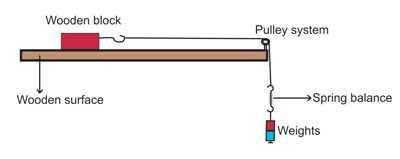|
Kinetic
friction, also known as dynamic or sliding friction occurs when a body is in
relative motion with another, with their surfaces in contact. It is the
frictional force that slows down, and eventually stops a moving object.
For
example, a soccer ball given a slight kick will begin to roll on the pitch, then
slows down, and then come to a stop. The ball is slowed down, and then stopped
after it has started moving with a velocity, as a result of the kinetic friction
between its surface and the pitch.
Without
confusing the two, the difference between static
friction and kinetic friction is that static friction occurs when the object
is stationary, that is, not moving, while kinetic friction takes place when the
object has started moving. It is kinetic friction that makes sure an object does
not continue to move forever when a force has acted on it as stated in Newton’s
first law of motion.
As
is the case with static friction, kinetic friction depends on the nature of the
materials or surfaces in contact, and the magnitude of the force that set the
body in motion. However, kinetic friction is less than static friction for the
same material surfaces in contact.
Kinetic
friction can be demonstrated in the laboratory by the following experiment:
A
wooden block placed on a wooden table is given a push to move it. It moves
forward for a while, slows down and come to a halt. It slows down because of the
kinetic friction that acted on its velocity, in the opposite direction to its
motion, which eventually brings it to a stop.
To
offset the existing kinetic friction between the wooden surfaces of both the
block and the table, additional forward force is required. This is made possible
by attaching a string to the block, and weights attached to the other end of the
string. With the aid of a pulley system as shown below, the attached weights
generate a forward force on the block making it to continue moving.

By
attaching the right weights on the string, the block will continue moving at
constant velocity. At this point the net force acting on the block is zero.
The
kinetic friction acting between the surfaces of two bodies in relative motion to
each other is represented by the formula:
Fk
= µk
R
Or
Fk =
µk
mg
Or
Fk =
µk
N
Where
Fk
stands for kinetic friction, µk
stands
for coefficient of kinetic friction; R
represents the force of reaction of the moving body on the surface of the
second, which is equal to mg. This is also the same as the normal force N
on the body.
See
coefficient of kinetic friction here
See static friction here
See
coefficient of static friction here
See
friction here
See
calculating friction here
|